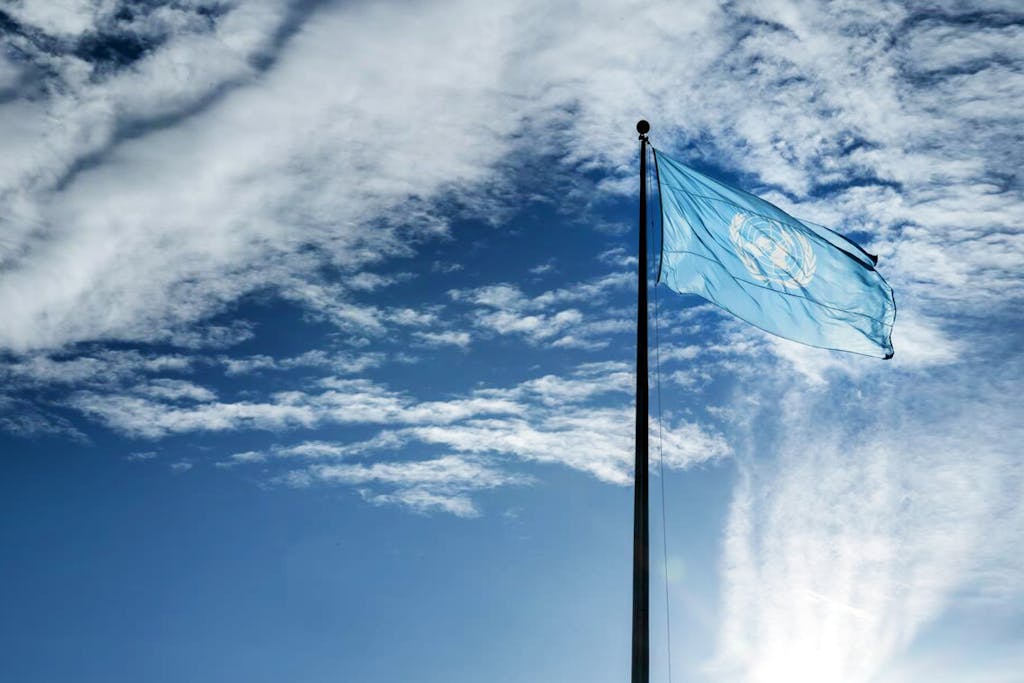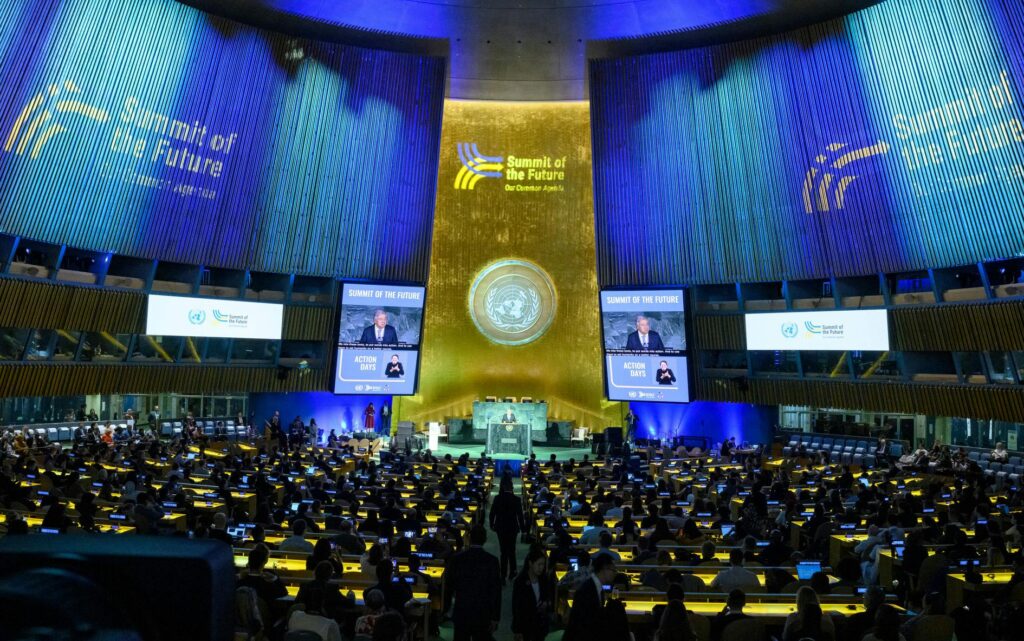

UN Secretary-General António Guterres delivers remarks at the Summit of the Future Action Days. Photo: UN / Loey Felipe
World leaders at the UN’s Summit of the Future adopted three foundational agreements to safeguard our future for generations to come, capping arduous negotiations. Imperfect but important, the Pact for the Future, Global Digital Compact, and Declaration on Future Generations provide an essential basis for action — a floor, not a ceiling, for the stepped up cooperation we need in a turbulent world.
Under pressure, the world has chosen the path of cooperation. Three landmark agreements were reached after extremely tough negotiations at the Summit of the Future in New York. This reflects the willingness of the overwhelming majority of UN Member States to find common ground in the face of conflict, polarization, and distrust.
At the beginning of the year, UN Secretary-General António Guterres warned the General Assembly of the risks of “a dangerous and unpredictable free-for-all.” The Pact for the Future — and the associated outcomes — show that governments are still determined to use the United Nations as a platform for global cooperation to tackle the most urgent issues facing humanity.
As we turn the page on the Summit, we have renewed opportunity to write a new chapter to ensure an international system that can think, plan, and act for the future. My early takeaways.
The Summit provides a foundation to fill critical gaps in collective action.
Multilateralism is hard. When the speeches are over and leaders have flown home from New York, abstruse arguments over negotiated text will quickly be forgotten. What will endure are concrete commitments that can be implemented, or emerging areas of consensus that provide the basis for global reform in 2025 and beyond. The Pact for the Future matters because it will catalyze innovations, collaborations, and coalitions with Member States and beyond, to fill critical gaps in collective action in areas where the United Nations has comparative advantage. The Global Digital Compact and Declaration on Future Generations open up new frontiers for international cooperation.

As the UN’s 80th anniversary approaches in 2025, we need progress at every milestone ahead of the official follow-up meeting to the Summit of the Future in 2028.
Photo: UN
The Pact is a blueprint for a more streamlined and effective international system.
With wars ravaging too many places, threats to peace and security are higher than at any time since the Cold War, while a new generation of global risks could have catastrophic impacts on people and planet. Global norms and standards — painstakingly developed over generations — are also under threat. With political support and broad stakeholder engagement, governments can use the Pact for the Future as a basis for strengthening international cooperation at a time of growing political tension, mobilizing all actors to prevent and respond to global shocks, and building support for common goals that allow countries with different views to work together effectively.
What is most important is often not what has caused the fiercest disagreements.
Any major summit is inevitably confronted with contentious issues that have deadlocked the United Nations for years — and even decades. The Summit of the Future is no different. Take peace and security. The Pact may have created space for a breakthrough on Security Council reform, but its legacy is more likely to be progress in less visible areas. The Peacebuilding Commission, for example, is given space to act as a platform for nationally owned prevention plans, in line with the 2030 Agenda commitment to reduce all forms of violence everywhere. The Protection of Civilians mandate is strengthened at a time when armed conflict is hitting people and their communities hard. New threats are addressed, including through the proposal for an instrument on Lethal Autonomous Weapons Systems. The Secretary-General also now has renewed authority to convene a global response the next time the world is confronted by a complex shock with impacts across regions and sectors.
A financing overhaul is moved to the forefront of the global conversation.
The Sustainable Development Goals (SDGs) face a $4 trillion financing gap, humanitarian needs are ballooning, and transitioning away from fossil fuels and dealing with climate impacts will require heroic investments, both public and private. The Pact offers a boost to the SDGs and climate finance by clearing a path for meaningful progress on reform. Its commitments on financing for sustainable development set the stage for the 2025 Financing for Development negotiations and climate finance discussions at COP 30. The Pact pushes critical issues like sovereign debt, resource mobilization, Special Drawing Rights, tax, and support to deal with systemic shocks to the center of the agenda. It adds pressure to secure a fit-for-purpose international financial architecture, especially if the World Bank and International Monetary Fund heed calls to increase voice and representation of developing countries. Although the Pact doesn’t immediately resolve current financial challenges, it creates momentum that holds promise for a more equitable and sustainable global financial system.

Panelists speak at an event to celebrate the global leadership of girls, ahead of the Summit of the Future. Intergenerational equity and youth leadership are vital to rebuilding hope for the future.
Photo: UN Foundation / Madalyn Owen
Finally, we’re seeing global cooperation for a digital age.
The United Nations was created at the same time as the first programmable computers. Eighty years later, digital technologies has transformed every aspect of our economies and societies. The Global Digital Compact provides a framework for closing digital divides, investing in public digital infrastructure, transferring technology to those who need it most, harnessing new technologies to deliver global goals, and global governance of artificial intelligence that accounts for human rights.
Intergenerational equity and youth leadership are vital to rebuilding hope for the future.
The Declaration on Future Generations matters more than you might think. Half the world’s people today are under 30, and the overwhelming majority of future generations will be born in Africa and Asia, largely in countries that have historically been marginalized in the international system. Improvements in global capacity to think, plan, and act for the future make it possible for “young countries” to protect the interests of both living and future generations, while securing the long-term future of the planet. In turn, the international system will only continue to thrive if these countries make continued and increasing use of it.
Now that the talking is over, we need an army of doers.
A global summit doesn’t change anything on its own, but it does create space for action. What matters now is whether coalitions of Member States and others work with energy and ambition to take forward the most significant proposals and reforms. A sustained Member State coalition, with leadership from both South and North, will be essential to delivery, but will only succeed if wider constituencies — academia, civil society, business, citizens — put their shoulders to the wheel. As the UN reaches its 80th anniversary in 2025, we need progress at every milestone ahead of the official follow-up meeting in 2028. Next year, can COP 30 in Brazil write a new chapter in climate cooperation? Will the first G20 in Africa mark a new deal for the world’s youngest region? Will the World Summit on Social Development secure the wellbeing of coming generations? Looking further ahead, can the first Biennial Global Economy Summit seal the deal to finance sustainable development? And how can we ensure that the selection of the next Secretary-General hands the baton to the next generation of leaders in the international system and finally sees a woman at the helm of the United Nations?
We spend a lot of time worrying about everything we’ve gotten wrong — and it’s a long list. But what if, just if — in this terribly complex but open moment in our collective story — we raise our sights, up our game, and get it right? That’s the opportunity of the Pact for the Future — let’s make sure it doesn’t go to waste.


